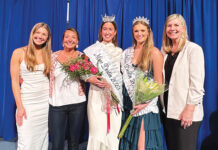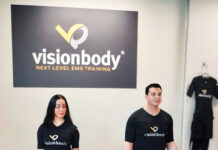By Lisa Leath Turpin
 Fitness styles seem to change as we learn more about what works and doesn’t work. In last month’s article, I mentioned that the American College of Sports Medicine (ACSM) added a new category to the exercise guidelines, Neuromotor Exercise, aka: Functional Fitness Training (FFT), recommending 2+ days/wk. Functional fitness training focuses on improving and maintaining motor skills such as balance, coordination, gait and agility. Neuromotor exercise can be especially beneficial for older people to improve balance and muscle strength, reducing the risk of falls and other injuryinjury, important safety measure as we age.
Fitness styles seem to change as we learn more about what works and doesn’t work. In last month’s article, I mentioned that the American College of Sports Medicine (ACSM) added a new category to the exercise guidelines, Neuromotor Exercise, aka: Functional Fitness Training (FFT), recommending 2+ days/wk. Functional fitness training focuses on improving and maintaining motor skills such as balance, coordination, gait and agility. Neuromotor exercise can be especially beneficial for older people to improve balance and muscle strength, reducing the risk of falls and other injuryinjury, important safety measure as we age.
Participating in functional resistance movements involving multiple muscle groups plus a significant degree of balance through multifaceted activities such as Tai Chi, Pilates or Yoga lends the stability needed for daily activities, which makes this training “Functional.” A recent study shows that people over age 50 should focus on agility training specifically. This can be somewhat uneasy training for some, as they are working on movements and with props that are unstable. Therefore, special care needs to go towards safety.
FFT is also of great benefit to athletes and sports players competing at any level, as improved agility, balance, proprioception and other motor skills can significantly help performance.
Interval training is a great solution for maximizing time and increasing results and helps combat boredom. It involves alternating bursts of intense movements followed by “active rest” that’s usually a lesser intensity of the same movement. In basic or traditional interval training, intervals can be based according to the needs of the participant and times and styles can vary. Interval training can be used to fulfill all categories of training (Cardio, Resistance, Neuromotor, even Flexibility).
Since interval training can be configured any way we choose, this is a great way to fit all the training disciplines into a 60-minute workout. I like to mix things up by alternating balance (core) training and cardio training within timed intervals.
Example #1: (2:1 ratio) 30 seconds on/15 seconds off (agility, cardio, core) — Round 1: “puddle jumpers” (side to side jumps). Tip: Use a flat yoga mat as a visual to jump over sideways pushing off hard to get good lateral training of the leg and glute. Round 2: “Russian twists” sit with bent knees, lean back, round your back, clasp your hands together or hold a ball and twist your upper body side to side, rotating at the torso, reaching your hands or ball as far as possible to each side. Tip: Your chest should turn following your hands. Alternate these two movements each 30 sec. interval with 15 second break for 8 rounds. Note: You should do 4 of each movement.
Example #2: 20 sec on/10 sec off (cardio, core) — Round 1: Jumping Jacks (low impact modifications avail) Round 2: one leg balance on disc note: use balance disc/balance trainer; an unstable surface to challenge your balance. Alternate through 8-10 rounds with 10 secs to rest and transition
Final thoughts: One of the most impressive evidence-based statements in the new ACSM Position Stand paper is that leadership from well-trained professionals will meaningfully enhance the exercise experience with adults, especially the novice exercisers. The fact that a position statement with over 400 cited references highlights the importance of skilled exercise professionals is a true measure of how much the profession of fitness training has grown in the last decade.
Visits: 0


























































